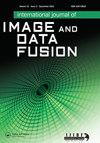Colour band fusion and region enhancement of spectral image using multivariate histogram
IF 1.8
Q3 REMOTE SENSING
International Journal of Image and Data Fusion
Pub Date : 2021-01-02
DOI:10.1080/19479832.2020.1870578
引用次数: 1
Abstract
ABSTRACT Multi-spectral satellite remote sensing imagery have several applications including detection of objects or distinguishing land surface areas based on amount of greenery or water etc. The enhancement of spectral images helps extracting and visualizing spatial and spectral features. This paper identifies some specific regions of interest (RoI) of the earth's surface from the remotely sensed spectral or satellite image. The RoI are extracted and identified as major segments. Trivially, uni-variate histogram thresholding is used for gray images as a tool of segmentation. However, for color images multivariate histogram is effective to get control on color bands. It also helps emphasizing color information for clustering purpose. In this paper, the 2D and 3D histograms are used for clustering pixels in order to extract the RoI. The RGB color bands along with the infrared (IR) band information are used to form the multivariate histogram. Two datasets are used to carry out the experiment. The first one is an artificially designed dataset and the next is Indian Remotely Sensed (IRS-1A) satellite imagery. This paper proves the correctness of the proposed mathematical implication on the artificial dataset and consequently perform the application on LandSat Spectral data. The test result is found to be satisfactory.基于多元直方图的光谱图像波段融合与区域增强
多光谱卫星遥感图像有多种应用,包括检测目标或根据绿化或水的数量区分陆地表面区域等。光谱图像的增强有助于提取和可视化空间和光谱特征。本文从遥感光谱或卫星图像中识别出地球表面的特定感兴趣区域(RoI)。提取RoI并将其识别为主要部分。通常,单变量直方图阈值被用于灰度图像作为分割工具。而对于彩色图像,多元直方图可以有效地控制颜色带。它还有助于强调用于聚类目的的颜色信息。本文采用二维直方图和三维直方图对像素进行聚类,提取RoI。利用RGB色带和红外波段信息组成多元直方图。实验中使用了两个数据集。第一个是人工设计的数据集,第二个是印度遥感(IRS-1A)卫星图像。本文在人工数据集上验证了所提数学含义的正确性,并在LandSat光谱数据上进行了应用。测试结果令人满意。
本文章由计算机程序翻译,如有差异,请以英文原文为准。
求助全文
约1分钟内获得全文
求助全文
来源期刊

International Journal of Image and Data Fusion
REMOTE SENSING-
CiteScore
5.00
自引率
0.00%
发文量
10
期刊介绍:
International Journal of Image and Data Fusion provides a single source of information for all aspects of image and data fusion methodologies, developments, techniques and applications. Image and data fusion techniques are important for combining the many sources of satellite, airborne and ground based imaging systems, and integrating these with other related data sets for enhanced information extraction and decision making. Image and data fusion aims at the integration of multi-sensor, multi-temporal, multi-resolution and multi-platform image data, together with geospatial data, GIS, in-situ, and other statistical data sets for improved information extraction, as well as to increase the reliability of the information. This leads to more accurate information that provides for robust operational performance, i.e. increased confidence, reduced ambiguity and improved classification enabling evidence based management. The journal welcomes original research papers, review papers, shorter letters, technical articles, book reviews and conference reports in all areas of image and data fusion including, but not limited to, the following aspects and topics: • Automatic registration/geometric aspects of fusing images with different spatial, spectral, temporal resolutions; phase information; or acquired in different modes • Pixel, feature and decision level fusion algorithms and methodologies • Data Assimilation: fusing data with models • Multi-source classification and information extraction • Integration of satellite, airborne and terrestrial sensor systems • Fusing temporal data sets for change detection studies (e.g. for Land Cover/Land Use Change studies) • Image and data mining from multi-platform, multi-source, multi-scale, multi-temporal data sets (e.g. geometric information, topological information, statistical information, etc.).
 求助内容:
求助内容: 应助结果提醒方式:
应助结果提醒方式:


